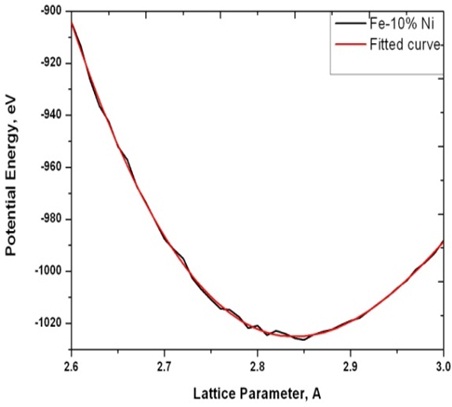Dear Steve and Axel,
I have run the input script provided in the example directory of LAMMPS. I am running my simulation on Intel Xeon 3.20GHz (4 CPU) (32 bit) machine with LAMMPS 31-Aug-2011 version and simulation is carried on single processor. I am getting results which is differing from the one provided with LAMMPS. I am attaching the compared results in tabulated excel sheet.
I want to know whether the obtained difference in result is acceptable or not.
…
Also, I have carried out other simulation for Fe-Ni binary alloy system.
I have defined a bcc structure of Iron of varying lattice parameter and introduced Nickel with set/fraction command. Initial velocity is created, then the system is minimized with minimize command and relaxed with NVE ensemble. Then I have maintained temperature of 298 K with NVT ensemble and final again using NVE ensemble to get the thermodynamic outputs. Time averaging is done to get the average properties as referred in LAMMPS manual.
Lattice parameter is varied from 2.8 to 2.9 Angstrom and potential energy is measured at each step.
Below is the graph showing the obtained results.

My ques are:
-
The way I set up the problem in LAMMPS is correct. ?
-
Why ain’t smooth curve is obtained. ? Or is this variation accepted .
Below is the input script.
To verify/calculate the lattice parameter of Iron.
Lattice parameter is decided by plotting energy values at # various lattice spacing.
log Fe-10%Ni.lammps
variable y equal 2.80
label iterations
atom_style atomic
units metal
boundary p p p
lattice bcc $y
region box block 0 5 0 5 0 5
create_box 2 box
create_atoms 1 box
set group all type/fraction 2 0.10 34245535
pair_style eam/alloy
pair_coeff * * Fe-Ni.eam.alloy Fe Ni
timestep 0.001
velocity all create 298.0 1234567
min_style cg
minimize 10e-5 10e-5 50000 50000
thermo_style custom step temp pe ke etotal press pxx vol
thermo 1000
thermo_modify lost ignore
fix 1 all nve
run 10000
fix 2 all nvt temp 298.0 298.0 10.0
fix 3 all temp/rescale 1 298 298 1 1
run 30000
fix 4 all nve
fix 5 all langevin 298 298 0.1 654866
fix 6 all press/berendsen iso 0.0 0.0 1.0
run 10000
variable e equal pe
variable v equal vol
fix 7 all ave/time 1 1000 5000 v_e
fix 8 all ave/time 1 1000 5000 v_v
run 15000
variable t equal f_4
variable y equal f_5
print “The current lattice parameter value is $y”
print “The current potential energy value is $t”
variable y equal $y+0.01
clear
if “$y <= 3.0” then “jump latpar iterations”
Thanks,
Agraj Abhishek
Results Compared Table.xls (51 KB)